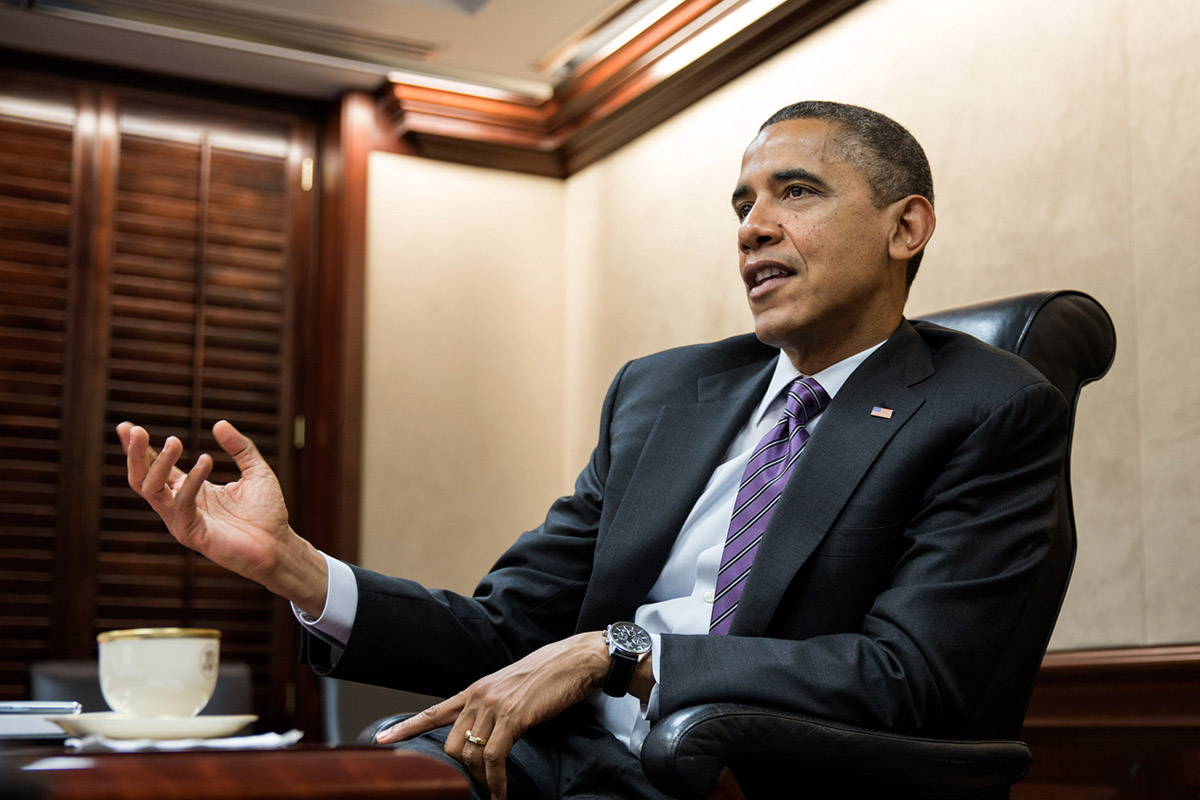
Shutterstock / White House
President Obama’s supporters, his critics, and the media all want the same thing from his climate speech today: drama. They want grand gestures, some sort of conversion narrative centered on Obama’s will to fight the climate fight. They want a “trade” for Keystone or a climate tax declaration or something about fracking, anything to fire up audiences and get clicks. Everyone has the same incentive nowadays, the green groups, the right-wing groups, the political media, they all want and need attention. In a fractured information environment, attention is money, and it’s measured in clicks. Drama gets clicks.
The Obama administration wants the opposite. It needs to reassure its environmental base and its international partners that it is working on climate change and intent on meeting its obligations. But high-profile climate drama could muck up the nomination of Gina McCarthy for EPA administrator, arouse the ire of the D.C. Circuit Court, piss off environmentalists yet again, torpedo the immigration reform effort, or, hell, just give the old white guys in the tricorner hats another excuse to march on the Mall, and aren’t we all a little tired of that?
Obama wants a no-drama climate plan that will quickly be swept from the news cycle by Supreme Court decisions and preparations for Obamacare implementation. He’s aware that the public is still spooked from the economic crash and ongoing weak recovery, in no mood to hear about sweeping, historic anything from the feds right now. That’s why the plan refers to “steady, responsible” action on climate twice in the first two pages. Steady as she goes. No reason to get worked up.
Why the no-drama approach?
In short, Obama has concluded, rightly I think, that it is of no benefit to him to have a pitched public battle over this stuff, no matter how much greens might want one. The kinds of things he’s doing (and pledging to do) on climate don’t need legislative approval or even public support. They are bowels-of-the-bureaucracy stuff, better done than discussed. Making them the subject of heated political debate could only screw them up.
As I said yesterday, Obama is in a highly constrained position on climate. He faces hostility from Congress and the courts alike, with no broad-based popular movement behind him to scare them into line. All he can do is use the power of the executive branch.
And so the plan is filled to the brim with bureaucratic language: partnerships and working groups and task forces, coordinating and standard-setting and sharing best practices. There’s much discussion of programs that are underway — a decent chunk of the plan amounts to “look at this thing we’re already doing” — and many pledges for further programs. It’s federal agencies doing what federal agencies do.
Even the biggest potential piece of drama, EPA standards on power plants, has been rendered drama-less. All the plan says is that Obama will issue a memorandum telling EPA to develop such standards. Well thanks! Sort of required by law, but whatever. It’s a decent-sized political deal, I guess, that he’s finally saying it outright. The burning question about these standards, though, is how strict they will be — they could range from a firecracker to a nuke, or hit the perfect sweet spot in the middle — but the plan says nothing at all about stringency, only that EPA must “work with states” (again, required by law) and make the standards “flexible” (again, right there in statute). There’s nothing here we didn’t already know.
The one bit of legitimate news made about EPA standards isn’t in the plan, but was revealed on a call with “senior administration officials” (sigh). Namely, there is a timeline: An initial proposal on existing plants will be out by June 2014, and a final rule by June 2015. Given how many court-ordered deadlines EPA has blown through, the words of an anonymous official this far in advance probably don’t mean much. But it’s something.
The only thing that really matters is that the rule be done before Obama leaves office, lest a Republican successor pull the old Bush don’t-open-the-email trick.
Anyway, very few people are going to wade through 21 dry PDF pages of micro-policies. I’m sure a “cross-agency National Drought Resilience Partnership” is just the ticket, but zzz. Very few people are interested in the mechanics of policy at this level. There will be a few days of attempts to frame this in dramatic terms and then everyone will forget it. Which is probably fine with the administration. The stuff that’s described in the plan can putter along perfectly well with a low profile.
But hey, we’re already here, talking about it, so … how should we assess this plan? Political journalists will focus on the costs, about which the plan says little (note, though, that many of the provisions will save consumers money, including all the efficiency standards, and many others will stimulate innovation and growth in new industries). Environmentalists will be obsessed with the greenhouse-gas reductions. On that score, the administration claims it’s still shooting for the 17 percent by 2020 target it promised in Copenhagen. Does this melange of micro-policies add up to 17 percent? There’s no evidence offered and no real way to know.
So is it just a nothingburger? Should the lack of drama disappoint us?
I don’t think so. One of the great illusions of the climate movement has always been that the problem would or could be solved with a grand, sweeping gesture like a climate tax or a binding international agreement. That has been a recipe for disappointment. In fact, making the changes necessary to deal with climate is going to mean a lot of “strong and slow boring of hard boards,” integrating climate into the ordinary business of government, assembling and disseminating information, drawing in new partners, and building up constituencies. This is the unsexy, difficult work of turning the ship of state.
I think new mileage standards for heavy vehicles will be a big deal. A Federal Quadrennial Energy Review will be a big deal. The federal government getting 20 percent of its energy from renewable sources by 2020 will be a big deal (the federal government is the world’s biggest energy consumer). Pulling together a network of cities to work on climate adaptation will be a big deal, as will work on HFCs, as will technology sharing with developing countries. All these will take place largely outside of public view, but cumulatively they are like acid eating away at resistance, making climate an ordinary, going concern for a new generations of businesspeople, political leaders, innovators, and federal employees.
This is vintage Obama. He refuses to wage lofty ideological battles, which frustrates the hell out of people who view those battles as necessary and inevitable. He doesn’t direct a lot of energy at bashing his head into walls. He just puts the available resources to work doing what can be done. It’s not enough — it’s not even as much as he could do — but it would be a big mistake to think it doesn’t matter.
UPDATE: Obama ended up making a surprise Keystone announcement in his speech. Read about it.
For more details and specifics on the plan, see: Obama’s climate plan in 3 easy bullet points (and a few sub-bullet points)



